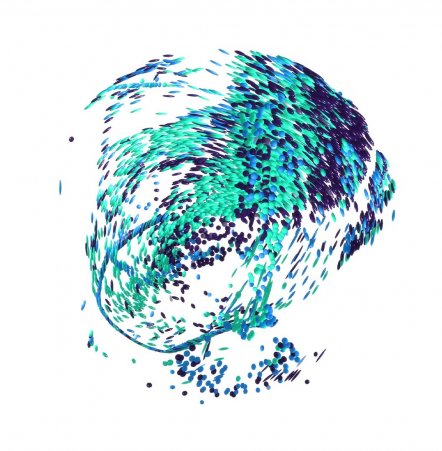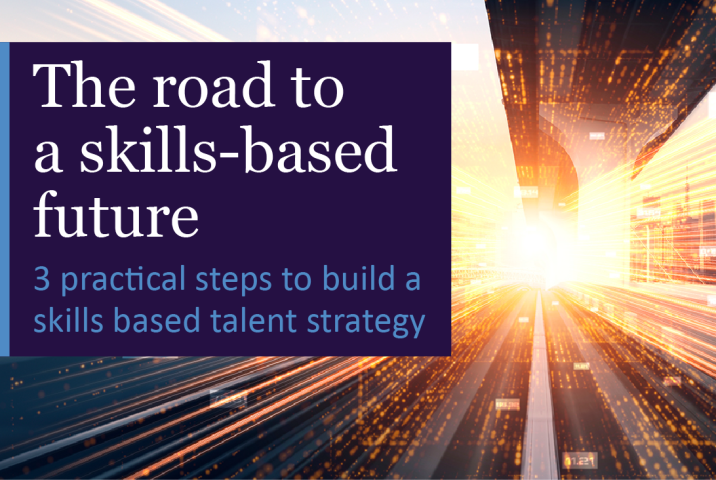With the right technology on our side, and taking a people-centred approach as we go, it’s time to enter the age of dexterity.
Barack Obama’s chief of staff, Rahm Emanuel, has become famous for his very particular views on crisis management: “You never let a serious crisis go to waste,” he said. “And what I mean by that, it’s an opportunity to do things you think you could not do before.”
By any objective standard, the COVID-19 global pandemic has been a crisis. It has certainly meant seismic shifts in the way we work, whether that’s remote working, virtual hiring or an even greater emphasis on the need for digital skills. We’ve all done things we thought we could never do before.
For talent leaders, it has been a challenge which brings in its wake a host of opportunities to reimagine work and to build true organisational resilience by looking to a workforce ready and able to navigate an age of uncertainty. And not just to survive. As leaders shift from the short-term ‘respond’ phase of the crisis to longer-term recovery, there’s growing evidence that thriving is at the heart of many an organisational strategy.
An experiment in changing workforce practices
It’s clear, though, that none of this is going to be easy. The pandemic is scarily open-ended: until we can rely on a much-needed vaccine, even the world’s best epidemiologists seem hard pressed to predict, with any accuracy, exactly how and where the pandemic might continue to strike. We’re simultaneously more than aware that the economic, social and cultural impacts of the virus are already significant and dramatic. And these impacts are being felt in different ways in different sectors. Compare, for example, the talent challenges of the travel and tourism industry with the continuing growth of a thriving pharma and life sciences sector.
Alain Proietti, talent lead at Danish healthcare company Novo Nordisk, speaks for many when he describes the past few months as “the biggest ever world experiment in changing workplace practices”. It’s a view mirrored by a recent article from Ravin Jesuthasan and colleagues published in Harvard Business Review, who emphasise that the pandemic’s impact is “fundamentally altering what work is performed and how we perform it”.
And this is not just a matter of those heroic clothing and fashion companies who turned their hands to producing personal protective equipment (PPE). It’s about nothing less than an extraordinary opportunity to rethink work, deploying work, skills and talent more flexibly than ever before.
I’m seeing a real move away from a culture of people needing to change employer to progress their careers.
Could it be that the crisis has provided the impetus for us to reimagine talent beyond the job description and traditional hierarchies, structures and workplaces? The gauntlet has been thrown down: the resilience we need in this unprecedented age of uncertainty can only come from making the most of the talent available to us – however and wherever it comes from. With the right tech on our side, and taking a people-centred approach as we go, it’s time to enter the age of dexterity.
Dexterity: the new agile
As COVID-19 hit, David Denyer, a professor at Cranfield School of Management, brought 20 years’ worth of research into risk and resilience to bear in an article that asks how organisations can improve their chances of weathering a “high-velocity crisis”. Denyer identifies two sets of opposing approaches that leaders tend to adopt in crisis situations: defensive vs progressive and consistent vs flexible.
He argues that successful organisational resilience strategies require leaders to adopt elements of all four approaches, with the balance shifting as the crisis develops. But they must avoid at all costs the “threat-rigidity effect” – the tendency to retrench into defensive mode so far that their organisations lose their capability to adapt to new opportunities. “Waiting out the storm” is not a viable option.
There’s plenty of evidence that the talent community is tackling this challenge head on, building on response-phase crisis management by embracing progressive, flexible strategies to build longer-term resilience.
Graeme Marshall, head of talent acquisition at energy tech company Baker Hughes, has a neat shorthand for the strategic workforce planning which underpins so much of the dexterity agenda: his company “buys, borrows and grows” talent as the demands of the business change.
With ‘buying’ less on the agenda as the business has retrenched, COVID has provided the opportunity to take stock, to create the internal fitness they know they’re going to need when the time comes to scale up again. On the ‘borrow’ side, Marshall’s contingent workforce programme lead creates the policies, manages the data and runs a cross-functional steering committee which brings together all relevant departments – HR, sourcing and procurement, legal – to compete in the contingent market. Redeployment has always been a reality for a company based on shifting product lines across regions and projects, and the learning team has deployed a suite of new tools to keep skills up to date, to keep the ‘grow’ side of the equation in balance.
Add in the realisation that remote working is a very real option for teams that need physical meeting space rather than permanent offices, and that the pandemic has had the perhaps unexpected effect of breaking down traditional hierarchies, with senior executives travelling less and engaging with staff more, and the groundwork for a flexible future looks to be in place.
For Noel Brown, senior director for global talent attraction and acquisition at Thermo Fisher Scientific, the crisis has been an evolution rather than a revolution, maximising the company’s total talent philosophy at a time when key areas of the business – on the frontline of testing, personal protective equipment, and the development and production of vaccines, antivirals and treatments – have been rapidly expanding (see p9).
Internal talent has been their starting point. Brown has a dedicated internal talent team and mobility systems that have created an internal market for jobs and career development.
Organisations have been able to muster considerable reserves of humanity during the pandemic.
Internal first
Internal first also seems to be a strategy of choice for companies in retrenchment as a result of the virus, or with a more stable workforce adapting to the realities of mass remote working.
Katie Calhoun, Alexander Mann Solutions’ head of client services, has seen this with a client in the travel industry, for whom large-scale redundancy is in the offing and, for the foreseeable future, business- critical hiring will be internal only for the most part. Not knowing exactly where those redundancies will hit requires considerable dexterity,
redeploying, reskilling and upskilling talent to fill gaps as they arise. Models that include resource augmentation are likely to be needed, as well as contingent workers, during the transition period, to allow for more flexibility, should the pandemic result in a second wave of redundancies.
Although this situation is not optimal, it does provide new avenues through which Calhoun can support her client. For her, the crisis has “accelerated opportunities for existing staff, and shone a light on the need for succession planning and internal mobility”. As the company works through recovery and rebuilding, these are strategies that will build resilience for the future.
Other companies have traded a commitment to no redundancies for changes in working practices – including redeployment and changes to roles and functions. Michelle Hainsworth, global head of client services at Alexander Mann Solutions, sees clients looking beyond traditional job descriptions, reskilling and redeploying talent to create nimbler teams as they enter the next phase of the pandemic – while preparing for potential aftershocks.
“I’m seeing a real move away from a culture of people needing to change employer to progress their careers,” she says. “We’re definitely in the era of internal headhunting and internal first.” The trend is towards transferable skills, encouraging people to view their roles in more flexible ways.
Widening the talent pool
Dexterity is also about viewing your talent pool in new ways. Alain Proietti at Novo Nordisk knows that great talent is sitting all over the world. These people have employment choices. “If we’re too rigid in our approach, they have options to go elsewhere,” he warns. His bosses may have raised their eyebrows when Proietti employed a manager based in Finland a couple of years ago, but the relationship has worked, and he perceives that COVID has already changed attitudes to geographical talent boundaries.
In their article, Jesuthasan and colleagues also reference what they call “cross-industry talent exchanges” – sharing employees between high- and low-demand sectors, equivalent of a sports team player loan. It’s also not surprising that, with sectors hit in different ways, companies experiencing growth are attracting talent from outside their usual talent pool.
At Thermo Fisher Scientific, Noel Brown has seen an increase in candidates from outside the life sciences sector. “Life science companies have inevitably been in the news during the pandemic, so our reach has broadened in ways we couldn’t otherwise pay for,” he explains. “Add in retrenchment elsewhere, and we’ve been attracting several thousand candidates for a single marketing role. Curiosity has led to engagement.”
Being human
These more open and flexible approaches to talent are not, of course, without their own challenges. While many people are happy to engage with these new opportunities, others may feel threatened or abandoned. Flexible, remote working has been a revelation for many, while others crave a return to the office. Many have, and will, lose their livelihoods, while ‘flexibility’ for others translates to increased workloads and pressure. Another thing we’ve definitely learned in recent months is that dexterity also needs to have a human face.
Insight from Deloitte suggests that companies at the cutting edge of “future of work practices” are likely to be well-positioned to meet the challenges of the pandemic – and beyond. It anticipates digital-savvy organisations made up of many types of worker and partners based anywhere in the world. As automation
bites, agile-minded humans will focus more on innovation, creativity and problem-solving. Workplaces will blend physical and virtual environments. Organisations will “value adaptability over procedure”.
Crucially, this vision of our brave new world also speaks to some very human talent challenges:
- the need for continuous learning to support upskilling and address continuing talent shortages
- the need to deliver a “consistent employer identity” to all types of employee, contractor and other stakeholder
- the need for “personalised” experiences to “empower people to be their best, balanced selves”.
The COVID-19 pandemic has been a resilience baptism of fire.
A focus on learning
The need for continuous learning and upskilling is far from a new idea in talent management, and the pandemic has only accelerated the need to equip people to meet the challenges they’re facing. Witness, for example, the changing face of management training to deal with mass remote working, or training to support redeployment.
Client and customer-facing organisations are also facing a complete rethink when it comes to handling customer relationships. It has been a disruptive time for sales and business-development functions, which have traditionally carried out business face to face. Cultural differences can impact here too; for example, the personal touch has always been seen as essential for selling into the Italian medical profession. Lawyers and business consultants have had to operate without those relationship- building lunches and networking events. Using multiple channels to interact with the external world is now a reality – and people need to be supported to adjust.
Cultures of learning will be a crucial underpinning for any dexterity-led organisation in future.
Communication, culture and consistency
There is plenty of evidence that organisations have been able to muster considerable reserves of humanity during the pandemic. Calhoun talks of “more kindness, caring and empathy” with “communication and care” at the core. There’s been plenty of intentionality in this space: managers checking in more regularly, daily company-wide coffee and chat sessions, shared Spotify playlists, even virtual meditation. Seeing our most senior colleagues communicating from their homes has created an unprecedented we’re-all-in-this-together bonhomie.
And, by and large, cutting people some slack and deploying more trust and compassion seems to have been repaid, with productivity and engagement holding up. The question now is: how can that people-centred focus be retained and enhanced? Is it sustainable?
Mutual life insurance, pensions and investments company Royal London’s initial response to the crisis led to 98% of its workforce operating remotely within six days of lockdown, even in roles that had previously never been performed this way.
For Victoria Wilson, head of people experience, this initial phase was all about providing practical help for staff as they moved to new ways of working (including a dedicated intranet site, toolkits to support remote working and support for all people leaders), while maintaining great service for their customers, keeping communication channels open and sustaining a sense of community. As a result, some customer satisfaction metrics have never been higher and engagement is strong.
Now, the challenge is to build on this momentum: “From a people- experience perspective, it’s important that our colleagues feel supported to continue to balance work and personal commitments,” says Wilson. “Providing true flexibility about where, when and how our people work is key to our future success.”
She is in no doubt that the company’s strong sense of values has been an asset. “The ‘spirit of Royal London’ is at the heart of our organisation,” she says. “We put our culture and our people’s health and wellbeing at the core of everything we do.”
Proietti similarly aspires to a more ‘flex-able’ organisation, where people work in a way that maximises their engagement and happiness as well as their productivity. But these kinds of hybrid model, with some staff working remotely and others in the office, need careful thought. New norms about flexible working must be clear and implemented equably across organisations.
Proietti gives the example of a recent meeting where some participants were back in the office and others still working remotely. Inevitably, the remote workers felt they were missing out on the informal chat that’s part of face-to-face interaction. Now, all meetings are conducted via screens to level the playing field.
Consistent and fair approaches to people who work in different ways will be essential. In any hybrid remote office-based model, for example, there’ll need to be even more of a focus on outputs. Harnessing the trust and humanity we’ve shown in crisis is a good starting point.
Partnership and preference
In a recent article, Lindsay McGregor and Neel Doshi looked at how best to motivate employees remotely. While, overall, their research suggests that people might be less motivated when working from home, a key factor relates to how much choice people have when it comes to where and how they work. Being able to express a preference, have some agency, matters.
At Royal London, Wilson is clear that the company’s future workplace strategy will be based around a partnership with its staff. She is using tools such as continuous engagement surveys and return-to-workplace working groups to plot a way through to the new reality. This sense of partnership and preference is part of Royal London’s goal to be an “inclusive, responsible and fulfilling” place to work.
More widely, it seems almost impossible that organisations will be able to ignore a wealth of survey data suggesting that flexibility is popular with a large percentage of the workforce. A more balanced approach between remote working and the interpersonal interaction most people want – some, if not all, of the time – looks likely. It could be that dexterity also means the decline of the one-size-fits-all workplace, with all that implies.
Cranfield’s Denyer defines organisational resilience as “an ability to anticipate, prepare for, respond and adapt to and learn from challenges and disruptions in order to survive and prosper”. The COVID-19 pandemic has been a resilience baptism of fire. When we ask ourselves “what next?”, we need to mind what we’ve learned, double down on those opportunities to change and reimagine the workplace in terms of the dexterity we all need to face an uncertain future.
Originally published in Catalyst Magazine The 'Dexterity' Issue.

















